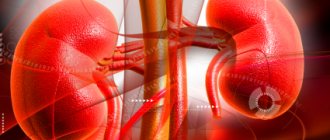Fanconi syndrome is a congenital metabolic pathology that involves the cessation of absorption (reabsorption) of glucose, phosphoric and carbonic acid salts, and amino acids by the renal tubules. As a result, a pathology is formed that can be classified as a special type of diabetes or rickets.
Another more detailed name for the disease - de Toni-Debreu-Fanconi syndrome or glucose-phosphate-amine diabetes - is associated with a clarification of the description of the disease by three authors. Since the first was the Swiss pediatrician Fanconi, who discovered characteristic signs of protein and glucose in the urine of a child with dwarfism and rickets, it is more popular in medicine to mention one name.
The disease often accompanies other hereditary metabolic pathologies (fructose intolerance, galactosemia, tyrosinemia). The prevalence is 1 case per 350 thousand live births.
Causes
Modern genetic studies have established the role of changes in chromosome 15 (encoded as 15q15.3). Inheritance of a mutant gene can occur in three types:
- autosomal recessive (optional);
- autosomal dominant (obligatory);
- linked to the X chromosome.
Mutations that occur for the first time are also found in children who do not have similar changes in their relatives.
Clinicians distinguish depending on the cause:
- primary Fanconi syndrome is an X-linked disease that is difficult to predict due to both recessive and dominant modes of inheritance;
- secondary – often accompanies other metabolic disorders.
Secondary disease occurs:
- with hereditary changes in the kidneys;
- possible development as a result of transplantation with insufficient tissue compatibility of the kidney of the donor and the patient;
- poisoning with mercury, lead salts, cadmium, uranium compounds;
- the influence of toluene, lysol and maleic acid in chemical production;
- therapy with platinum-based drugs, antibiotics Gentamicin and Tetracyclines (the use of expired medications is of particular importance).
Etiology
Most often, the syndrome is a component of other hereditary diseases: cystinosis, tyrosinemia type I, galactosemia, Wilson's disease, fructose intolerance. Familial variants of the syndrome are inherited autosomal recessively, autosomal dominant, or linked to the X chromosome.
The type of inheritance is autosomal recessive; there is also an autosomal dominant form with the gene localized on chromosome 15q15.3. The expressivity of the mutant gene in the homozygous state varies significantly. There are sporadic cases caused by a fresh mutation. It is believed that the disease is based on genetically determined defects in enzymatic phosphorylation in the renal tubules (combined tubulopathy), deficiency of enzymes of the 2nd and 3rd complexes of the respiratory chain - succinate dehydrogenase and cytochrome oxidase. Scientists classify the diseases as mitochondrial diseases.
How the disease develops
The main pathology develops in the mitochondria of cells. These intracellular structures are the “energy production factory” for all activities. To obtain the necessary kilocalories, a phosphorylation process involving oxygen occurs in the mitochondria.
A biochemical reaction requires a set of enzymes for step-by-step transformations. But in Fanconi syndrome they are absent in the cells of the renal tubular epithelium. Consequently, mitochondria cannot supply the required amount of energy. Reabsorption of necessary substances into the blood suffers.
Electron microscopy view of mitochondria, insufficient energy production deprives the organ and tissue of the ability to function
Excreted in urine:
- glucose;
- albumins;
- phosphates;
- amino acids;
- bicarbonates.
A deficiency of these substances is registered in the blood and the overall metabolism changes:
- a lack of amino acids and bicarbonates leads to a shift in the acid-base balance towards acidification (acidosis), while the breakdown of bone tissue increases;
- The absorption of potassium and calcium in the renal tubules is further reduced, and the elements are removed in the urine.
The child's skeleton shows signs of rickets. Closer to adulthood, a process of softening of bone tissue occurs - osteomalacia.
Provoking factors
Fanconi syndrome is more likely to occur in people with the following inherited disorders:
- failure in the metabolic processes of cystine (amino acids in proteins);
- intolerance to dairy products (even breast milk);
- defects in various enzymes responsible for the synthesis and breakdown of glycogen;
- failure in the metabolism of aromatic amino acids;
- fructose intolerance;
- problems with copper metabolism (Konovalov-Wilson disease);
- disruption of myelin metabolism and dysfunction of the enzyme sulfatase;
- constant exposure to toxins on the body (medicines, poisons, heavy metals);
- failure in metabolic processes involving protein, which leads to the deposition of a specific complex - amyloid;
- acute vitamin D deficiency.
Symptoms in children
Symptoms of the disease are noticed in a child after 6 months of age:
- children move little;
- appetite is significantly reduced;
- muscles develop poorly;
- constantly asked to drink;
- vomiting often occurs;
- temperature rises without connection with signs of infection;
- are lagging behind in weight gain and physical development;
- excrete a lot of urine (polyuria);
- dry, dehydrated skin.
A clearer picture is formed in the second year of life, and sometimes at 5-6 years. Here the first place is taken by:
- manifestations of deformation of bone tissue and skeleton;
- paralysis caused by hypokalemia.
The lag in physical and mental development is beyond doubt. The child grows up fearful and unsociable.
Up to a year, the child should be examined monthly by a pediatrician
Bone changes appear:
- in leg deformities;
- "duck" gait;
- violation of the shape of the chest and spine;
- altered structure of the humerus and forearms;
- significantly reduced muscle tone.
Bones become brittle. For this reason, the child often experiences fractures. The patient's height is shorter than his peers.
Based on the degree of metabolic disturbance and the severity of the patient’s condition, there are 2 clinical variants of Fanconi syndrome:
Alport syndrome in children
- The first is that the delay in physical and intellectual development is significant, the course of the disease is dominated by severe disorders with severe hypocalcemia (up to 1.6-1.8 mmol/l), bone fractures and deformities, calcium absorption decreases not only in the renal tubules, but also in the intestine .
- The second is that the delay in physical development is less pronounced, the child is mentally almost normal, bone deformations are minor, the course is assessed as mild, there is a sufficient concentration of calcium in the blood, and the intestines absorb calcium well.
The result of the disease is:
- pathological changes in the nervous system;
- blurred vision;
- defects in the development of the genitourinary organs;
- chronic intestinal diseases;
- state of immunodeficiency;
- renal failure.
Notes
- ↑ 123456789
Small encyclopedia of endocrinologist / Ed. A. S. Efimova. — 1st ed. - K.: Medkniga, DSG Ltd., Kyiv, 2007. - P. 340. - 360 p. — (“Library of a practicing physician”). — 5000 copies. — ISBN 966-7013-23-5. - ↑ 12345
Symptoms and syndromes in endocrinology / Ed. Yu. I. Karachentseva. — 1st ed. - Kh.: LLC "S.A.M.", Kharkov, 2006. - P. 165-166. — 227 p. — (Reference manual). — 1000 copies. — ISBN 978-966-8591-14-3.
Manifestation of the syndrome in adults
In adulthood, a person develops secondary Fanconi syndrome. It manifests itself:
- frequent excessive urination (polyuria);
- complaints of weakness;
- bone pain;
- decreased muscle tone;
- tendency to recurrent fractures;
- changes in the kidneys lead to persistent hypertension.
The disease is most severe in postmenopausal women, when hormonal influences on the electrolyte balance are added. Brittle bones lead to severe fractures:
- spine;
- head of the femur.
This means complete disability, the impossibility of fusion of bone tissue. Kidney failure develops gradually. The glomerular epithelium atrophies and is replaced by scar tissue.
Compression fracture of the vertebrae is dangerous due to compression of the spinal cord
Prognosis and prevention
The disease is associated with a high mortality rate. In the early stages, it is possible to compensate for the occurring disorders, but the syndrome progresses, which is accompanied by severe electrolyte imbalance and renal failure. The prognosis when the disease is detected is unfavorable.
Preventive recommendations have not been developed to date, since the pathogenesis of the problem has not been studied. To prevent congenital anomalies, doctors advise contacting geneticists at the pregnancy planning stage. Adults need to prevent the development of diseases that can provoke the occurrence of the syndrome.
Diagnostics
Detection of the disease is based on x-ray and biochemical laboratory methods. X-rays reveal:
- various deformations of the bones of the limbs;
- thinning and atrophy of the cortical layer in the tubular bones;
- looseness in growth zones;
- violation of the structure and shape of the spine;
- poorly healing fractures;
- osteoporosis of all bone tissue of varying severity;
- lag in growth rate according to the child’s age.
Among the biochemical disorders detected in the blood:
- decrease in calcium and phosphorus concentrations;
- growth of the enzyme alkaline phosphatase;
- hypokalemia;
- excess parathyroid hormone;
- disturbance of the acid-base balance towards acidosis.
Urine contains:
- normal or increased calcium secretion;
- increased content of phosphate salts;
- glucose content far exceeds the renal threshold (20–30 g/l and above);
- natriuria;
- significant levels of amino acids.
Treatment
Treatment for secondary Fanconi syndrome is aimed at treating the disease that caused its development - its symptoms significantly decrease or disappear completely with successful treatment of the underlying disease. For congenital syndrome, therapy should begin as early as possible and be comprehensive. Its main goals are aimed at replenishing the deficiency of electrolytes (calcium, potassium bicarbonates and phosphorus) and eliminating acidosis. In addition, symptomatic therapy is prescribed. For severe consequences of Fanconi syndrome, hemodialysis and surgical treatment are performed.
Diet
To eliminate the deficiency of calcium, potassium bicarbonates and phosphorus and prevent the excretion of amino acids, patients with Fanconi syndrome are recommended to follow a special diet:
- introducing into the diet dishes from potatoes and cabbage, milk, dried fruits (raisins, dried apricots, prunes), fruit juices;
- limiting the consumption of table salt;
- drinking plenty of water.
In case of severe potassium deficiency, in addition to following a diet, it is necessary to take potassium-containing products (Asparkam, Panangin).
Drug therapy
To eliminate disturbances in phosphorus-calcium metabolism, medications with vitamin D are prescribed. Initially, the drugs are administered at a dose of 10-15 thousand IU per day, and then the dosage is gradually increased to the permissible maximum - 100 thousand IU. While taking these medications, control blood tests are performed to determine calcium and phosphorus levels. When these indicators stabilize, vitamin D intake is stopped.
In addition, patients with congenital Fanconi syndrome are prescribed a course of calcium and phytin supplements. If signs of renal failure and other consequences of the disease appear, symptomatic treatment is carried out.
In case of secondary Fanconi syndrome, medications are prescribed to treat the underlying disease.
Physiotherapy
After achieving remission - elimination of acidosis and disturbances of phosphorus-calcium metabolism - courses of massage and balneotherapy (salt-pine baths) are prescribed.
Hemodialysis
With the development of chronic renal failure, hemodialysis is prescribed.
Surgery
When severe bone deformities appear, surgical correction is recommended. Such operations can be performed only after the onset of stable remission, confirmed by laboratory tests, lasting at least 1.5 years. The type of surgical interventions is determined individually, and their goal is aimed at restoring the structure and mobility of the musculoskeletal system.
Differential diagnosis
For an accurate diagnosis, it is necessary to distinguish the identified signs from rickets-like diseases and complications of hereditary and other diseases. They are distinguished by an additional more complete examination of blood, urine, kidney function, and bone marrow.
Such conditions include:
- juvenile nephronophthisis;
- galactosemia;
- cystinosis;
- tyrosinemia;
- glycogenosis;
- fructose intolerance;
- multiple myeloma;
- hepatobiliary dystrophy;
- amyloidosis;
- hyperfunction of the parathyroid glands;
- consequences of kidney transplantation;
- Sjögren's syndrome;
- nephrotic syndrome,
- toxic kidney damage due to poisoning with heavy metal salts;
- overdose of drugs, including vitamin D.
Differential diagnosis is carried out by a qualified specialist
Classification
There are primary (idiopathic) and secondary forms of Fanconi disease. The primary form develops as a result of inheritance of a defective gene. The secondary form occurs with other congenital, genetically determined diseases.
Secondary syndrome can occur against the background of acquired pathologies:
- paraproteinemia - the presence of abnormal protein bodies in the blood;
- nephrotic syndrome - severe disorders that develop when the glomeruli of the kidneys are damaged;
- tubulointerstitial nephropathy - a group of kidney diseases characterized by primary damage to the tubules;
- malignant neoplasm (paraneoplastic syndrome);
- intoxication due to poisoning;
- severe burns.
Forecasts
The prognosis depends on the underlying disease against which the syndrome developed. If the underlying disease is a neoplasm, if it is successfully removed, the prognosis can be relatively favorable.
Fanconi disease causes the development of complex consequences that lead to disability of the patient. Death occurs with renal failure, when hemodialysis no longer has the desired effect and kidney transplantation is not performed. Or death may occur due to unsuccessful organ transplantation.
Pathogenesis
Fanconi syndrome, or glucoaminophosphate diabetes, which is more common among domestic authors, develops due to impaired transport of substances through the membranes of the renal tubules. The cause of this condition has not yet been fully elucidated by pathophysiologists, but its consequences are well known.
Secondary changes in the body, reminiscent of rickets, are the result of prolonged acidosis and a decrease in the level of phosphorus in the blood, as well as a decrease in the amount of ATP (adenosine triphosphate).
- Nephrotic syndrome in children: causes, symptoms, treatment and prevention of the disease
There are congenital and acquired Fanconi syndrome. The first, as a rule, is combined with fermentopathy, fructose intolerance, and pathological accumulation of glycogen. Acquired syndrome is a consequence of taking toxic drugs, for example, chemotherapy, cytostatics or antiretroviral drugs. In addition, this symptom complex may appear after a kidney transplant, with amyloidosis and myeloma.










